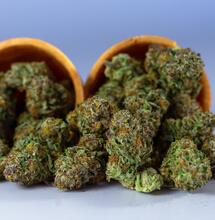Exercise and Marijuana: Do They Mix?

Medical marijuana is legal in 26 states and recreational use is legal in seven states and the District of Columbia. As a result, more people are able to access pot and use it in a variety of circumstances – exercise not excluded. That’s right: While a popular perception of marijuana users is the spaced-out stoner unable to get off the couch and face the day, advocates of marijuana use for athletes say they are proving this stereotype wrong.
But, from a research perspective, how marijuana actually affects athletic performance remains to be seen. Even in states where the drug is legal, researchers may be hesitant to devote shrinking budgets to the topic or attach their names to this type of research. As views and attitudes continue to change, however, more well-designed and controlled studies may emerge.
U.S.News
We do know, however, that everybody responds to marijuana use differently, and that the boom in production (at least publicly) has yielded tremendous variety in the strands of the drug, each of which likely carries its own unique effects and side effects. Here’s what else the limited available research suggests about how well (or poorly) marijuana affects different aspects of athletic performance:


Pain Management
Athletes often talk about marijuana as a pain reliever. They’re not wrong: In addition to offering actual pain management (hence its legalization medically in many places), marijuana appears to alter the emotional response to pain by distracting the individual from feelings of pain and fatigue, and refocusing their energy on the task at hand – a valuable benefit for long-duration athletes like runners or cyclists. Still, pain management is a bit of a long-shot reason for most of us recreational exercisers to use pot before workouts.
Focus
“Mind over matter” is a helpful mantra among many endurance athletes, who may find that the ability to block out the monotony of a long-duration event is just as important as physical ability. Marijuana may help facilitate that mindset since the part of the brain that responds with a pleasant buzz when exposed to the tetrahydrocannabinol – known as THC – in marijuana is that same part that fires when athletes feel a “runner’s high.”
Energy Level
Marijuana drawbacks include forgetfulness, lethargy, lack of motivation and anxiety. Some users claim that even if physical performance falls somewhat following use, it’s still worth it for the pain management and focus benefits.


Motor Skills
Marijuana causes changes in visual perception, coordination and reaction time, all of which will negatively impact the ability to exercise, particularly if the activity requires complex movements and high levels of agility. This may be one reason why the proponents of marijuana use prior to exercise typically discuss simple, repetitive activities like long-distance running as opposed to sports like tennis or golf.
Anxiety
How marijuana affects anxiety levels during exercise (or elsewhere) varies widely. Some users say it reduces their anxiety and may even lower resistance in the airway, which would potentially drive some performance benefits. Other users report increased feelings of anxiety and paranoia.
So, should you use?
While the pros and cons of pre-workout marijuana use may warrant additional study, there are serious negative side effects that should not be ignored in the quest to enhance physical performance.
First, filling your lungs with smoke is never a good thing. Marijuana smoke can cause irritation and inflammation of the lungs and bronchial tubes, which damages how well your respiratory system works. In the long run, while we don’t know as much about the risks of smoking marijuana as we do about smoking cigarettes, smoking pot could cause respiratory problems and may contribute to the onset of lung cancer.
Even if you use choose to consume edible forms of THC to avoid the side effects related to smoke inhalation, you’re not entirely in the clear. After all, marijuana, no matter how it is consumed, adversely impacts short-term memory and long-term use could impair overall cognitive function. Among young people, marijuana use impacts areas of the brain that regulate everything from emotion to motivation, and may fundamentally alter the physiology of the brain itself in potentially damaging ways.
Finally, while many of the studies on marijuana’s impact on physical performance are a few decades old, the research that does exist suggests that it impairs performance rather than enhances it. Marijuana use decreases work capacity and cardiac output, meaning that the heart and muscles will not be able to perform at their best. Couple that with the increase in heart rate that accompanies marijuana use and you may create a perfect storm for a person with an underlying cardiac condition or who is new to exercise and has not undergone adequate screening to be sure he or she does not have risk factors.
Stated simply, marijuana is not something anyone should add to his or her routine in the hopes that it will enhance physical performance. There are simply too many risks and unknowns associated with regular use, not the least of which is the building up of a tolerance that requires heavier usage to achieve the same results. You’re far better off seeking a runner’s high the natural way – by running.
SOURCE
S
Soft Secrets



